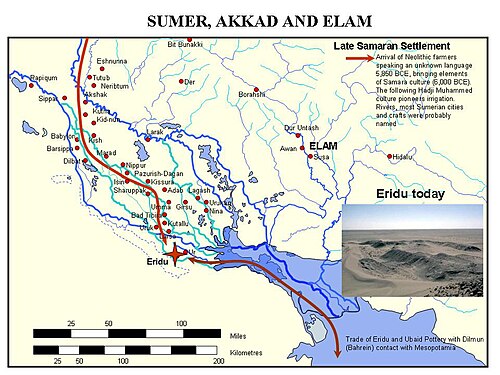Eridu
Eridu (or Eridug/Urudug, from Sumerian Eri.dugga, "Good City"), coordinates: 30°48′57″N 45°59′46″E / 30.81584°N 45.99607°E) was an ancient city seven miles southwest of Ur. Eridu was the southernmost of the conglomeration of cities that grew about temples, almost in sight of one another, in Sumer, southern Mesopotamia.
In Sumerian mythology, it was said to be one of the five cities built before the flood. The cities were from North to South : Sippar, Larak, Shuruppak, Bad-tibira and Eridug.
It appears to be the earliest Sumerian settlement, most likely founded ca. 4000 BC close to the Persian Gulf near the mouth of the Euphrates River; but with accumulation of silt at the shoreline over the millennia, the remains of the city are now some distance from the gulf at Abu Shahrain in Iraq.
In early Eridu, Enki's temple was known as E-abzu ("the abzu temple") and was located at the edge of a swamp, an apsû.[1]

History
The apparent continuity of occupation and religious observance at Eridu provide convincing evidence for the indigenous origin of Sumerian civilization. Kate Fielden reports "The earliest village settlement (c.5000 BC) had grown into a substantial city of mudbrick and reed houses by c.2900 BC, covering 8-10 ha (20-25 acres). By c.2050 BC the city had declined; there is little evidence of occupation after that date. Eighteen superimposed mudbrick temples at the site underlie the unfinished Ziggurat of Amar-Sin (c.2047-2039 BC). In the court of Assyria, special physicians trained in the ancient lore of Eridu, far to the south, foretold the course of sickness from signs and portents on the patient's body, which we must not too hastily connect with "symptoms" in scientific medicine, and they offered the appropriate incantations and magical resources.
Eridu in myth
In the Sumerian king list, Eridu is named as the city of the first kings:
- After the kingship descended from heaven, the kingship was in Eridu. In Eridu, Alulim became king; he ruled for 28800 years. Alaljar ruled for 36000 years. 2 kings; they ruled for 64800 years. Then Eridu fell and the kingship was taken to Bad-tibira.
The king list gave particularly long rules to the kings who came before the "flood", and shows how the centre of power progressively moved from the south to the north of the country.
Adapa U-an, elsewhere called the first man was a half-god half-man, culture hero, called by the title Abgallu (Ab=water, Gal=Great, Lu=Man) of Eridu. He was considered to have brought civilisation to the city from Dilmun (probably Bahrain), and he served Alulim.
In Sumerian mythology Eridu was the home of the Abzu temple of the god Enki, the Sumerian counterpart of the Akkadian water-god Ea. Like all the Sumerian and Babylonian gods, Enki/Ea began as a local god, who came to share, according to the later cosmology, with Anu and Enlil, the rule of the cosmos. His kingdom was the waters that surrounded the world and lay below it (Sumerian Ab = Water; Zu = far).
The stories of Inanna, the Goddess of Uruk, describe how she had to go to Eridu in order to receive the gifts of civilisation. At first Enki, the God of Eridu attempted to retrieve these sources of his power, but later willingly accepted that Uruk now was the centre of the land. This seems to be a mythical reference to the transfer of power northward, mentioned above.
Babylonian texts also talk of the creation of Eridu by the god Marduk as the first city, "the holy city, the dwelling of their [the other gods] delight".
External links
Archeological searches
Tell Abu Shahrain was excavated in the 1940s by Fuad Safar and Seton Lloyd. It is near actual Bassora.
The site was excavated chiefly between 1946 and 1949 by the Iraq Antiquities Department.
[2] These Archaeological investigations were carried out in the 1940s, which showed, according to Oppenheim, "Eventually the entire south lapsed into stagnation, abandoning the political initiative to the rulers of the northern cities," and the city was abandoned in 600 BC.
References
- Margaret Whitney Green, Eridu in Sumerian Literature, Phd disseration, University of Chicago, 1975.
- A. Leo Oppenheim, Ancient Mesopotamia: Portrait of a dead civilization.
- Gwendoyn Leick, Mesopotamia: The invention of the city.

